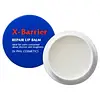Kosé Dr. Phil Cosmetics X-Barrier Repair Lip Balm Versus Tiaraleen Bioprogramming Lip Line Timecess 907D Plus Eccolange
What's inside
What's inside
 Key Ingredients
Key Ingredients

 Benefits
Benefits

 Concerns
Concerns

 Ingredients Side-by-side
Ingredients Side-by-side

Diisostearyl Malate
EmollientTriisostearin
Skin ConditioningPhytosteryl/Behenyl/Octyldodecyl Lauroyl Glutamate
Skin ConditioningCetyl Ethylhexanoate
EmollientPetrolatum
EmollientDextrin
AbsorbentPolyglyceryl-2 Triisostearate
EmulsifyingPolybutene
Hydrogenated Polyisobutene
EmollientSynthetic Wax
AbrasiveSilica Dimethyl Silylate
EmollientDipotassium Glycyrrhizate
HumectantSuizendinori Polysaccharide
Tocopherol
AntioxidantPanthenol
Skin ConditioningButylene Glycol
HumectantBHT
AntioxidantEthylene/Propylene Copolymer
AbrasiveGlycerylamidoethyl Methacrylate/Stearyl Methacrylate Copolymer
HumectantGlycerin
HumectantSqualane
EmollientSorbitan Sesquioleate
EmulsifyingParaffin
PerfumingPolyethylene
AbrasiveMicrocrystalline Wax
Emulsion StabilisingWater
Skin ConditioningHydrogenated Microcrystalline Wax
Emulsion StabilisingPhenoxyethanol
PreservativeDiisostearyl Malate, Triisostearin, Phytosteryl/Behenyl/Octyldodecyl Lauroyl Glutamate, Cetyl Ethylhexanoate, Petrolatum, Dextrin, Polyglyceryl-2 Triisostearate, Polybutene, Hydrogenated Polyisobutene, Synthetic Wax, Silica Dimethyl Silylate, Dipotassium Glycyrrhizate, Suizendinori Polysaccharide, Tocopherol, Panthenol, Butylene Glycol, BHT, Ethylene/Propylene Copolymer, Glycerylamidoethyl Methacrylate/Stearyl Methacrylate Copolymer, Glycerin, Squalane, Sorbitan Sesquioleate, Paraffin, Polyethylene, Microcrystalline Wax, Water, Hydrogenated Microcrystalline Wax, Phenoxyethanol
Cetyl Ethylhexanoate
EmollientHydrogenated Polydecene
EmollientPolyglyceryl-2 Triisostearate
EmulsifyingDiisostearyl Malate
EmollientHydrogenated Polyisobutene
EmollientSynthetic Wax
AbrasivePhytosteryl/Octyldodecyl Lauroyl Glutamate
Skin ConditioningPetrolatum
EmollientEthylene/Propylene Copolymer
AbrasiveCoix Lacryma-Jobi Ma-Yuen Bran Oil
HumectantPrunus Amygdalus Dulcis Oil
Skin ConditioningEuphorbia Cerifera Cera
AstringentSimmondsia Chinensis Seed Oil
EmollientMacadamia Ternifolia Seed Oil
EmollientPrunus Avium Seed Oil
EmollientHelianthus Annuus Seed Oil
EmollientPersea Gratissima Oil
Skin ConditioningCorylus Americana Seed Oil
Skin ConditioningStearyl Glycyrrhetinate
Skin ConditioningTocopherol
AntioxidantCitric Acid
BufferingSodium Citrate
BufferingCI 45380
Cosmetic ColorantBasic Red 1:1
CI 19140
Cosmetic ColorantCI 15985
Cosmetic ColorantCetyl Ethylhexanoate, Hydrogenated Polydecene, Polyglyceryl-2 Triisostearate, Diisostearyl Malate, Hydrogenated Polyisobutene, Synthetic Wax, Phytosteryl/Octyldodecyl Lauroyl Glutamate, Petrolatum, Ethylene/Propylene Copolymer, Coix Lacryma-Jobi Ma-Yuen Bran Oil, Prunus Amygdalus Dulcis Oil, Euphorbia Cerifera Cera, Simmondsia Chinensis Seed Oil, Macadamia Ternifolia Seed Oil, Prunus Avium Seed Oil, Helianthus Annuus Seed Oil, Persea Gratissima Oil, Corylus Americana Seed Oil, Stearyl Glycyrrhetinate, Tocopherol, Citric Acid, Sodium Citrate, CI 45380, Basic Red 1:1, CI 19140, CI 15985
Ingredients Explained
These ingredients are found in both products.
Ingredients higher up in an ingredient list are typically present in a larger amount.
Cetyl Ethylhexanoate is an emollient ester. It comes from cetearyl alcohol and 2-ethylhexanoic acid.
Cetyl Ethylhexanoate is an emollient that adds a velvety feel to skin without being greasy or oily. Emollients help trap moisture into your skin, keeping your skin soft and hydrated.
Diisostearyl Malate is an emollient and most often used in lip products. It comes from isostearyl alcohol, a fatty acid, and malic acid, an AHA.
As an emollient, Diisostearyl Malate helps create a thin film on your skin to trap moisture in. This helps keep your skin soft and smooth.
Ethylene/Propylene Copolymer is an exfoliant.
Hydrogenated Polyisobutene is a synthetic polymer. Polymers are compounds with high molecular weight. Hydrogenated Polyisobutene is an emollient and texture enhancer.
In one study, Hydrogenated Polyisobutene showed better skin hydration levels than Caprylic/Capric Triglyceride. As an emollient, it helps keep your skin soft and hydrated by trapping moisture in.
Hydrogenated Polyisobutene is often used as a mineral oil replacement.
Learn more about Hydrogenated PolyisobutenePetrolatum is more commonly known as petroleum jelly. It is created by mixing waxes and mineral oils.
This ingredient is effective at reducing water loss by 99%. This is because it is an occlusive. Occlusives create a hydrophobic barrier on the skin to prevent evaporation. This property makes it great for hydrating dry skin.
Pro tip: Use occlusives, such as this ingredient, on damp skin for the best results.
The quality or origin of petrolatum is only known when disclosed by the brand. Most cosmetic petrolatum has gone through several purification stages.
Another benefit of occlusives is it protects your skin against infection or allergies.
Petrolatum may not be safe for fungal-acne. Studies show mineral oil / petroleum leads to the growth of M. Furfur, a type of yeast.
Learn more about PetrolatumThis ingredient is a form of glycerin with emulsifying and emollient properties.
As an emulsifier, this ingredient helps keep products together while adding a thick texture. The manufacturer states this ingredient has emollient properties. Emollients help keep the skin hydrated by trapping moisture in.
Polyglyceryl-2 Triisostearate is created by reacting diglycerin and isostearic acid. Due to the isostearic acid base, it may not be safe for Malassezia or fungal acne.
Learn more about Polyglyceryl-2 TriisostearateSynthetic Wax is created from fossil fuels such as natural gas. It is used to enhance texture, adjust pH, and as an occlusive.
It may also be used as an abrasive ingredient to exfoliate the skin.
Synthetic Wax may not be fungal acne safe.
Learn more about Synthetic WaxTocopherol (also known as Vitamin E) is a common antioxidant used to help protect the skin from free-radicals and strengthen the skin barrier. It's also fat soluble - this means our skin is great at absorbing it.
Vitamin E also helps keep your natural skin lipids healthy. Your lipid skin barrier naturally consists of lipids, ceramides, and fatty acids. Vitamin E offers extra protection for your skin’s lipid barrier, keeping your skin healthy and nourished.
Another benefit is a bit of UV protection. Vitamin E helps reduce the damage caused by UVB rays. (It should not replace your sunscreen). Combining it with Vitamin C can decrease sunburned cells and hyperpigmentation after UV exposure.
You might have noticed Vitamin E + C often paired together. This is because it is great at stabilizing Vitamin C. Using the two together helps increase the effectiveness of both ingredients.
There are often claims that Vitamin E can reduce/prevent scarring, but these claims haven't been confirmed by scientific research.
Learn more about Tocopherol